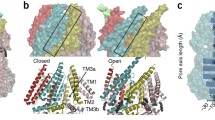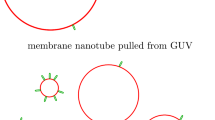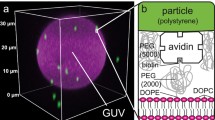Abstract
Cells respond to applied external forces through different mechanosensitive processes, with many of them based on the interaction between membrane-embedded proteins and their lipid environments. This interaction can depend on membrane curvature at the location of such proteins. Here we elucidate the general characteristics of a macroscopically defined protein–lipid bilayer interaction based on a mismatch between the shape of the protein surface and the surrounding membrane curvature. It is shown how the parameters of this interaction are related to the experimentally determined distribution of membrane-embedded proteins between highly curved tubular and flat membrane regions of a giant phospholipid vesicle. The results obtained for such distribution of potassium channel KvAP are presented as an example. Possible participation of the curvature-dependent protein–lipid bilayer interaction in mechanosensitive processes is indicated.





Similar content being viewed by others
References
Aimon S, Callan-Jones A, Berthaud A, Pinot M, Toombes GES, Bassereau P (2014) Membrane shapes modulate transmembrane protein distribution. Develop Cell 28:212–218
Anishkin A, Loukin SH, Teng J, Kung C (2014) Feeling hidden mechanical forces in lipid bilayer is an original sense. Proc Natl Acad Sci 111:7898–7905
Battle AR, Petrov E, Prithwish P, Martinac B (2009) Rapid and improved reconstitution of bacterial mechanosensitive ion channel proteins MscS and MscL into liposomes using a modified sucrose method. FEBS Lett 583:407–412
Bavi N, Nakayama Y, Bavi O, Cox CD, Qin QH, Martinac B (2014) Biophysical implications of lipid bilayer rheometry for mechanosensitive channels. Proc Nat Acad Sci 111:13864–13869
Božič B, Kralj-Iglič V, Svetina S (2006) Coupling between vesicle shape and lateral distribution of mobile membrane inclusions. Phys Rev E 73:041915(11)
Božič B, Das LS, Svetina S (2015) Sorting of integral membrane proteins mediated by curvature-dependent protein–lipid bilayer interaction. Soft Matter 11:2479–2486
Brohawn SG, Campbell EB, MacKinnon R (2014) Physical mechanism for gating and mechanosensitivity of the human TRAAK K+ channel. Nature 516:126–130
Cuello LG, Cortes DM, Perozo E (2004) Molecular architecture of the KvAP voltage-dependent K+ channel in a lipid bilayer. Science 306:491–495
Fournier JB (1996) Nontopological saddle-splay and curvature instabilities from anisotropic membrane inclusions. Phys Rev Lett 76:4436–4439
Jiang Y, Lee A, Chen J, Ruta V, Cadene M, Chait BT, MacKinnon R (2003) X-ray structure of a voltage-dependent K+ channel. Nature 423:33–41
Kralj-Iglič V, Svetina S, Žekš B (1996) Shapes of bilayer vesicles with membrane embedded molecules. Eur Biophys J 24:311–321
Kralj-Iglič V, Heinrich V, Svetina S, Žekš B (1999) Free energy of closed membrane with anisotropic inclusions. Eur Phys J B 10:5–8
Markin VS, Sachs F (2004) Thermodynamics of mechanosensitivity. Phys Biol 1:110–124
Martinac B (2014) The ion channels to cytoskeleton connection as potential mechanism of mechanosensitivity. Biochim Biophys Acta 1838:682–691
Mim C, Unger VM (2012) Membrane curvature and its generation by BAR proteins. Trends Biochem Sci 37:526–533
Mondal S, Khelashvili G, Weinstein H (2014) Not just an oil slick: how the energetic of protein–membrane interactions impacts the function and organization of transmembrane proteins. Biophys J 106:2305–2316
Nassoy P, Lamaze C (2012) Stressing caveolae new role in cell mechanics. Trends Cell Biol 22:381–389
Nuccitelli R (1978) Ooplasmic segregation and secretion in the Pelvetia egg is accompanied by a membrane-generated electric current. Dev Biol 62:13–33
Phillips R, Ursell T, Wiggins P, Sens P (2009) Emerging roles for lipids in shaping membrane–protein function. Nature 459:379–385
Sorre B, Callan-Jones A, Manzi J, Goud B, Prost J, Bassereau P, Roux A (2012) Nature of curvature coupling of amphiphysin with membrane depends on its bound density. Proc Natl Acad Sci 109:173–178
Sukharev S, Sachs F (2012) Molecular force transduction by ion channels-diversity and unifying principles. J Cell Sci 125:3075–3083
Svetina S, Žekš B (1989) Membrane bending energy and shape determination of phospholipid vesicles and red blood cells. Eur Biophys J 17:101–111
Svetina S, Žekš B (1990) The mechanical behavior of cell membranes as a possible physical origin of cell polarity. J Theor Biol 146:115–122
Svetina S, Kralj-Iglič V, Žekš B (1990) Cell shape and lateral distribution of mobile membrane constituents. In: Kuczera J, Przestalski S (eds) Biophysics of membrane transport, vol II, pp 139–155
Yoshimura K, Sokabe M (2015) Mechanosensitivity of ion channels based on protein–lipid interaction. J R Soc Interface 7:S307–S320
Zhu C, Das SL, Baumgart T (2012) Nonlinear sorting, curvature generation, and crowding of endophilin N-BAR on tubular membranes. Biophys J 102:1837–1845
Acknowledgments
Drs. Bojan Božič and Roger Pain critically read the manuscript. Drs. Bojan Božič and Jure Derganc helped in preparing Figs. 2 and 3, respectively, and Mr. Marjan Verč helped in preparing Figs. 1, 4, and 5. This work was supported by the Slovenian Research Agency through the research program P1-0055.
Author information
Authors and Affiliations
Corresponding author
Additional information
Special issue title “Biophysics of Mechanotransduction”.
Rights and permissions
About this article
Cite this article
Svetina, S. Curvature-dependent protein–lipid bilayer interaction and cell mechanosensitivity. Eur Biophys J 44, 513–519 (2015). https://doi.org/10.1007/s00249-015-1046-5
Received:
Revised:
Accepted:
Published:
Issue Date:
DOI: https://doi.org/10.1007/s00249-015-1046-5




